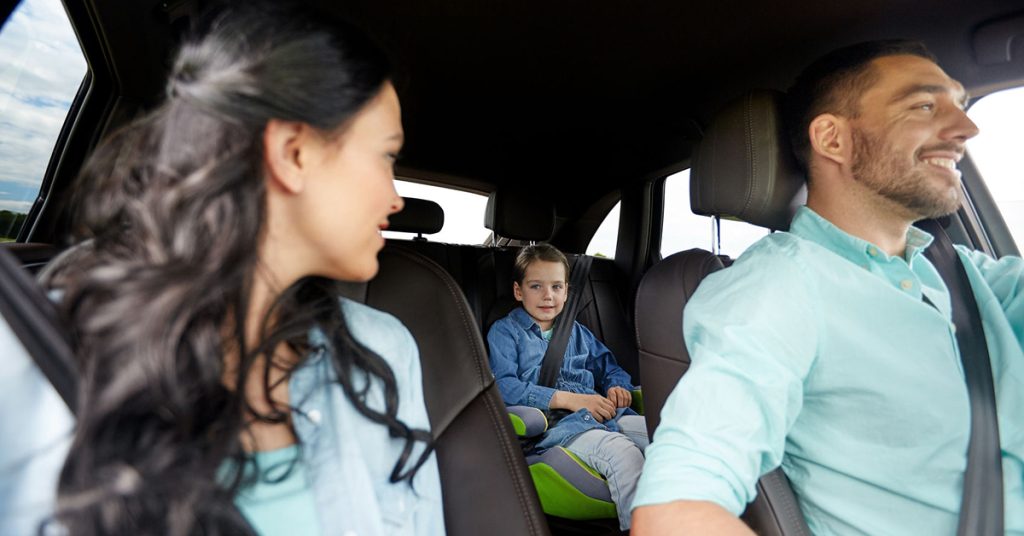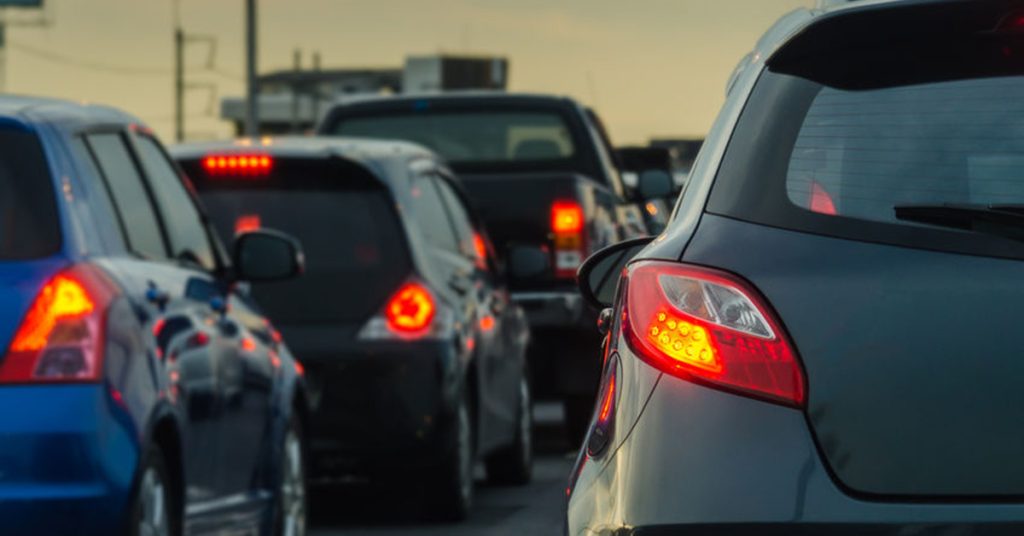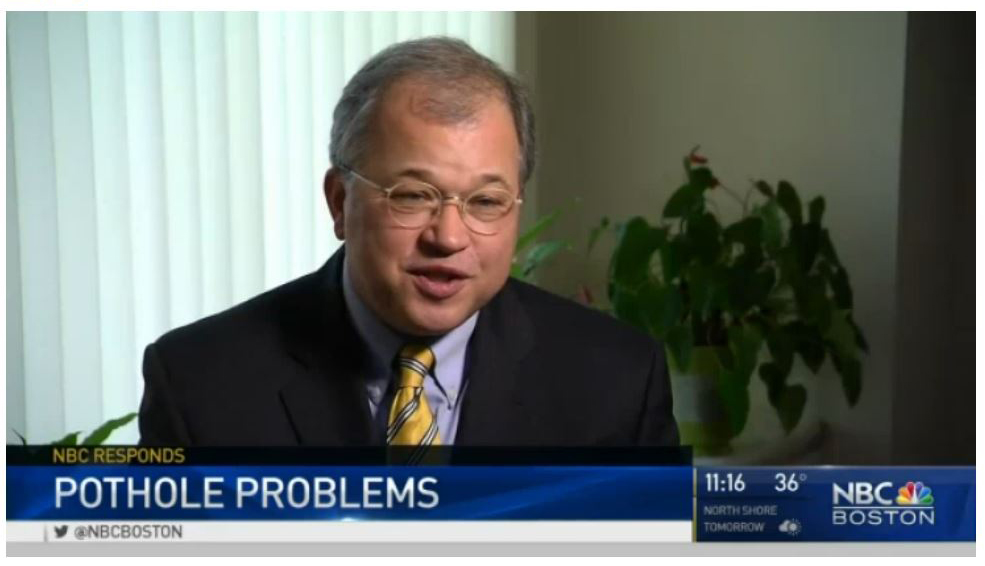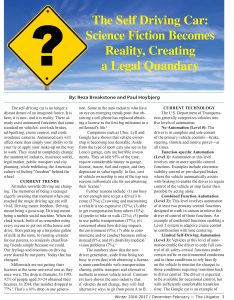Posts Tagged ‘“Boston car accident lawyers”’
Preventing Injuries: Check Your Seat Belts and Child Passenger Safety Seats
 There is nothing more important than protecting your family and other passengers in the car. Many of us drive less often in the winter in Massachusetts. But in a few weeks, families will be back in the car more for afterschool sports, activities and weekend trips.
There is nothing more important than protecting your family and other passengers in the car. Many of us drive less often in the winter in Massachusetts. But in a few weeks, families will be back in the car more for afterschool sports, activities and weekend trips.
Take a few minutes now to inspect your vehicle’s seat belts and child passenger safety seats. Make sure this equipment is working and properly adjusted to fit each child. Replace car seats if your children have outgrown them. Then talk to your family about the importance of always wearing a seat belt.
Dangers on the Road for Children
- Roughly 3 children in the U.S. die each day as a result of motor vehicle accidents, according to the National Highway Traffic Safety Administration (NHTSA).
- Car accidents increased 5.6 percent nationwide from 2015 and 2016. Child deaths in motor vehicle accidents increased 8 percent.
- Children were occupants in 74 percent of fatal car accidents in 2016. They were pedestrians in 20 percent of cases and were on bikes in about 5 percent of cases.
Seat Belt: Buckle Up, Every Ride
Your car should have working seat belts. Do a visual inspection and also sit in each seat while buckling up. If your seat belts are not working, call your auto dealer to have them repaired. Then, wear your seat belt on every trip, no matter how short. Insist your children and other passengers do as well. Drivers carry a lot of influence when it comes to seat belt use, especially parents.
Properly buckle your children in, especially when they are just transitioning from booster seats to seat belts. As they get older, they will start to buckle themselves in, but continue to check their seat belt before you start driving, even if just from the front seat. You want to make sure the straps are not tangled or jamming. Buckle up unused seat belts to discourage children from playing with them. Always lock your power windows so children cannot operate them from the backseat and finally, never leave your children alone in motor vehicles to play with seat belts unsupervised in your vehicle.
Watch this video to see how to buckle your child in:
Teenagers may need the most reminders, whether they are passengers or drivers. In 2016, 47 percent of young drivers who died in crashes were not wearing seat belts, according to the NHTSA. As a parent, you have to teach your teenager to be both a safe driver and a safe passenger and always, always wear seat belts. The decisions your children make while driving with friends are critical.
Massachusetts Law on Seat Belts
In Massachusetts, children must start wearing seat belts at age 8 or when they outgrow their child passenger safety seat.
The Massachusetts seat belt law requires drivers and passengers to wear seat belts while traveling in the front and back of vehicles. According to the Governors Highway Safety Association (GHSA), Massachusetts is one of 15 states which have a secondary enforcement seat belt law. While seat belts must be worn, drivers can only be cited for a seat belt violation after they are stopped for an unrelated traffic offenses. In primary enforcement states, drivers can be pulled over solely for not wearing a seat belt.
Seat belt use was 89.7 percent in 2017, according to the NHTSA. This increased about 5 percent from 2009, which is good news. Except that seat belt use was the lowest in the Northeast. Some 86.5 percent of drivers and passengers buckled up, compared to 94.5 percent out West. The best thing you can do is go for a 100 percent seat belt rate in your car.
Child Safety Seats: The Challenge
Car accidents are the leading cause of death for children and teenagers, according to the Centers for Disease Control and Prevention (CDC). Safe Kids Worldwide reports child passenger safety seats can reduce the risk of death by 71 percent. The problem is car seats can be hard to install, expensive and are frequently recalled.
Massachusetts has a Child Passenger Safety Seat law to protect young passengers:
- Children who are younger than 8 years old (or under 57 inches tall) must use an age-appropriate federally-approved child safety seat.
- Child safety seats should be placed in the back seat (if your vehicle doesn’t have a back seat, you can’t install the car seat in the front seat).
- Older children must wear a seat belt. It is recommended that children sit in the back seat until they reach age 13.
Parents must use an age appropriate car seat. Infants typically use a rear-facing car seat until age 2, then grow into a forward facing car seat and then a booster seat. Check these guidelines for help purchasing a child passenger safety seat.
Help Finding the Right Child Passenger Safety Seat
Common Mistakes in Fitting Car Seats
- Rear-facing infant/convertible seats are often installed with the wrong amount of incline while forward-facing car seats can be fit too loosely.
- A forward-facing seat should not be able to move more than an inch laterally. In one study, the NHTSA found more than 17 percent of forward-facing car seats were able to move more than 2 inches.
- A common mistake with booster seats is the lap belt position. Lap belts should sit on the child’s hips and thighs, not the abdomen or rib cage.
Source: NHTSA, National Child Restraint Use Special Study, June 2015
Where You Can Find Help
If you are having trouble with your car seat installation, ask if your local police department offers free car seat inspections. You can also check this website to find other resources in the area.
Child Car Seat Safety Information from Manufacturers
Register your child safety seats with the manufacturer so you will be notified if there is a recall. Even when you carefully research a product, these recalls can and do happen. Graco has recalled millions of child car seats, most for unsafe buckles, but also other defects. Other manufacturers have issued recalls when seats have failed to mount and when pieces posed a potential choking hazard.
Finally, read the manufacturer’s instructions for set up and check the expiration date. Many people do not realize that car seats have an expiration date.
About Breakstone, White & Gluck
For more than 30 years, the lawyers of Breakstone, White & Gluck have represented individuals and families who have been injured by negligent and reckless drivers in Massachusetts. Our Boston car accident lawyers are committed to fighting for justice for every client and have been consistently recognized for our results by Super Lawyers, U.S. News – Best Law Firms and Martindale Hubbell.
For a free legal consultation, contact us at 800-379-1244 or 617-723-7676 or use our contact form.
Ready to Go? Getting out of Boston Safely for Thanksgiving
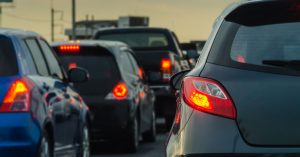
Driving to your Thanksgiving destination can be demanding. Read our tips to help you get there safely with a little less stress (if that’s possible).
We all want to know the secret to beating the Thanksgiving week traffic out of Boston. To help, we have put together a few travel tips. Please travel safely, be patient and enjoy this special time of year with your family and friends.
Traffic Apps and Resources. Here are a few websites for travelers: Boston.com/Traffic or Mass511.com. Traffic apps: Google Maps, Waze, AAA or GoTime.
Boston’s Worst Traffic Bottlenecks. AAA is reporting on the Boston region’s 10 top traffic bottlenecks for the Thanksgiving holiday weekend. They include several locations along Interstate 93, Interstate 95 and the MassPike (Interstate 90). Read the full list now before you drive. Try to avoid them if you can.
Check Your Car. Whether you drive your own car or rent a vehicle, spend a few minutes in the driver’s seat before you leave. Make sure you know how to use key features such as the blinkers, headlights and the heating system. Many new vehicles now have complex infotainment systems. Decide now what features you need to use for this trip – and which are distractions.
Essentials. Make sure your motor vehicle registration is in your glove compartment and that you have your health insurance card (or cards if you are a parent traveling with children).
Choose the Best Travel Times. AAA predicts a 3 percent increase in holiday travel this year, so we know to expect more traffic. Tuesday night and Wednesday afternoon will be the most challenging time, according to Waze. Another busy travel time is Thanksgiving Day between 11 a.m. and 1 p.m.
Plan to Stop. Take a break to fend off fatigue and let kids burn off energy. Stop once every two hours.
Gas Up and Emergency Kit. Always start your trip with a full tank of gas. Then, make sure you have a strong emergency kit, with jumper cables, a quart of motor oil, coolant, a first aid kit and a toolkit. Find your auto club membership, a safety vest, a flashlight with extra batteries and a roadside flare. Finally, pack warm clothes, blankets and your cell phone charger.
Commit to Use Your Cell Phone Safely. Our best tip for you is to turn your phone off. If you are traveling with someone, ask them to hold your cell phone and receive occasional phone calls or traffic alerts for you.
When traffic is heavy, a driver can cause a multi-car pile-up with a single glance at a cell phone – and that’s on any given day. The traffic is much worse during the Thanksgiving Week. That is why texting while driving is banned in Massachusetts and 46 other states, and why many are pushing to see Massachusetts ban all cell phone use by drivers.
No Drinking and Driving Accidents. Drunk driving accidents increase during the holiday season, starting with Thanksgiving week. Always, always travel with a designated driver who agrees not to drink. Or do not consume alcohol. No one ever regrets making this decision the next morning.
Distracted Driving Study: One in Four Drivers Are Using Cell Phones Before Crashes
Here is another reason for Massachusetts and other states to consider passing laws which ban handheld cell phone use by drivers. A new study reports one in four drivers who crashed was using a cell phone within the previous minute. Cambridge Mobile Telematics released the study last week to coincide with April’s Distracted Driving Awareness Month.
Our country needs a reminder this year. Motor vehicle accident deaths are on the rise, as the National Safety Council reported nearly 40,000 deaths in traffic crashes last year. In fact, the period from 2014 to 2016 saw the largest two-year increase in more than 50 years.
Meanwhile, this year has already seen hundreds of deaths across the U.S. Just last month came a horrific accident in Texas. A driver in Uvalde County, who was texting while driving his pick-up truck, crashed into a church bus, killing 13 people. Texas is one of 5 states which do not ban texting while driving.
New Distracted Driving
Over the past 18 months, Massachusetts-based Cambridge Mobile Telematics tracked about 1,000 car accidents via its smartphone app called DriveWell. Some insurance companies offered customers the app and provided incentives for safe driving.
The app uses a smart phone’s sensors to track driver behaviors, such as the way a phone is held. Drivers in stopped vehicles were not counted. The app tracks distracted driving behaviors at speeds greater than 9 miles per hour. Some 29 percent of the distracted drivers were traveling much faster though, over 56 mph.
Massachusetts is one of 45 states which bans the practice of texting while driving. The state’s ban has been in place since September 2010.
Drivers can still make phone calls, except for junior operators who are under age 18 and bus drivers. Though the Massachusetts state Senate did approve a handheld cell phone ban in 2016, the bill never cleared the state House of Representatives.
Allowing drivers to make handheld cell phone calls is a safety hazard and makes it hard for police to enforce the state’s texting while driving ban. Many argue police cannot differentiate between a driver picking up their phone to make a call or reaching for it to check their e-mail or text messages.
But the DriveWell study gives the state of Massachusetts another reason to consider a cell phone ban. Some 14 states already have these bans, including New Hampshire.
Reducing the Distractions in Your Car
Most people think of distracted driving as cell phone use, texting and checking your Facebook accounts. But the distractions run deeper. Distracted driving is really any behavior that takes your attention off the road, including eating, drinking or being engaged in conversations with passengers that take your attention off the road. Think about your own driving routine. How can you reduce the distractions?
About Breakstone, White & Gluck
The Boston car accident lawyers at Breakstone, White & Gluck have over 100 years combined experience representing those who have been injured in car accidents, truck accidents and motorcycle accidents. If you have been injured, learn your rights for seeking compensation. For a free legal consultation, contact our attorneys at 800-379-1244 or 617-723-7676 or use our contact form.
Report: Dramatic Rise in Traffic Accidents in 2016
Driving on U.S. roads became more dangerous in 2016. Preliminary data from the National Safety Council shows more than 40,000 people died in motor vehicle crashes last year, a 6 percent increase from 2015.
- This was the first year more than 40,000 people have died in traffic accidents since 2007.
- According to The New York Times, 2015 and 2016 saw a 14 percent increase in traffic deaths, the largest two-year increase in more than half a century.
- In addition to deaths, an estimated 4.6 million people suffered serious injuries in car accidents last year. The total costs came to $432.5 billion, for motor vehicle deaths, injuries and property damages.
- In Massachusetts, 399 traffic deaths were reported in 2016, a 13 percent increase over the prior year (these are also preliminary figures).
The National Safety Council said lower gasoline prices and an improving economy may be helping to fuel the rise in traffic deaths. Others point to seat belt laws and texting while driving and other distracted driving behaviors.
If you drive, take to the roads safely. Follow the speed limit and make sure everyone in your family puts down their cell phone while driving.
Read our Article: Understanding and Buying Auto Insurance in Massachusetts
Until it happens to you, few people understand the costs associated with a car accident, and the toll on your physical health and emotional well-being. We hope you are never injured, but encourage you to read our article to protect yourself and your family.
Attorney David W. White Is Interviewed for NBC Boston Story on Pothole Damage and Car Accidents in Massachusetts
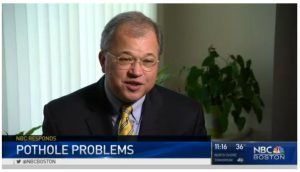 Just as sure as it brings snow, winter in Massachusetts always brings potholes. When drivers hit potholes, their cars can sustain major damage, sometimes totaling in the thousands of dollars. They often want to file a claim against the state or community which maintains the road.
Just as sure as it brings snow, winter in Massachusetts always brings potholes. When drivers hit potholes, their cars can sustain major damage, sometimes totaling in the thousands of dollars. They often want to file a claim against the state or community which maintains the road.
NBC Boston recently aired a story on what rights consumers have if their vehicle is damaged by a pothole (1/24/2017). Attorney David W. White was interviewed and delivered bad news for drivers. Under Massachusetts law, drivers do have 30 days to file a claim against a town or state. But drivers are unlikely to recover any money because the state and towns will claim “contributory negligence.”
“If you are one percent at fault, you get zero percent recovery,” he said.
We encourage you to watch the segment here: http://tinyurl.com/zlt8kvo.
About Breakstone, White & Gluck
The Boston car accident lawyers at Breakstone, White & Gluck are experienced at handling auto accident claims involving serious injury. If you have been injured, learn your rights. For a free legal consultation, contact us today at 800-379-1244 or 617-723-7676 or use our contact form.
Attorney Reza Breakstone Co-Authors Article on Legal Ramifications of Self-Driving Cars in California Lawyers Publication
 Attorney Reza Breakstone writes about the legal ramifications of self-driving cars in an article published in the Winter 2016-2017 edition of The Litigator, the official publication of the Capital City Trial Lawyers Association in Sacramento, California. Attorney Breakstone co-authored the article with Attorney Paul Hoybjerg of Roseville, California. In the article, “The Self Driving Car: Science Fiction Becomes Reality, Creating a Legal Quandary,” the authors write the time has come for the self-driving car.
Attorney Reza Breakstone writes about the legal ramifications of self-driving cars in an article published in the Winter 2016-2017 edition of The Litigator, the official publication of the Capital City Trial Lawyers Association in Sacramento, California. Attorney Breakstone co-authored the article with Attorney Paul Hoybjerg of Roseville, California. In the article, “The Self Driving Car: Science Fiction Becomes Reality, Creating a Legal Quandary,” the authors write the time has come for the self-driving car.
“The self-driving car is no longer a distant dream of an imagined future. It is here, it is now, and it is reality. There already exist automated functions that come standard on vehicles: anti-lock brakes, self-parking, cruise control, and crash avoidance cameras. Automated cars will affect more than simply your ability to tie your tie or apply your make-up on the way to work. They stand to completely change the automotive industry, insurance world, legal market, public transport and city planning, while redefining the American culture of feeling “freedom” behind the wheel.”
The article explains the current levels of automation among vehicles on the market, investments in the industry and ramifications for auto insurers and plaintiffs and defendants in personal injury cases.
“The less thrilling ramifications may be to the bottom line of auto insurers and the plaintiffs’ and defense bars in personal injury cases. Currently, auto insurance premiums account for $200 billion nationwide. The insurance industry, with decreased vehicle ownership and decreased liability issues on the part of the user, will find itself cut out of the equation. Allstate Corp. Chairman Thomas Wilson predicts that driverless cars will have “the most detrimental impact on auto insurance” and one “we don’t want to wait” to figure it out.”
About Attorney Reza Breakstone
Attorney Reza Breakstone joined Breakstone, White & Gluck as an associate in 2015. Learn more about Reza on our website.
Attorney Marc L. Breakstone Responds After State Police Announce Former Patriots Player Brandon Spikes Will Be Charged With Leaving Scene of Personal Injury Crash
Attorney Marc L. Breakstone spoke to Fox 25 News Boston after State Police issued a citation charging former New England Patriots linebacker Brandon Spikes in the hit-and-run accident that injured a family of three. Breakstone is representing the family.
“It’s surprising to them that Mr. Spikes would drive so recklessly and then just leave the scene,” Breakstone told the news station. “It will affect them for a long time. This could have been a story with a tragic ending.”
Spikes will be charged with leaving the scene of a personal injury crash, operating a motor vehicle negligently to endanger, speeding and failure to stay within marked lanes. He was cut by the New England Patriots after State Police opened the investigation.
Parents: Time to Talk to Teen Drivers About Safety
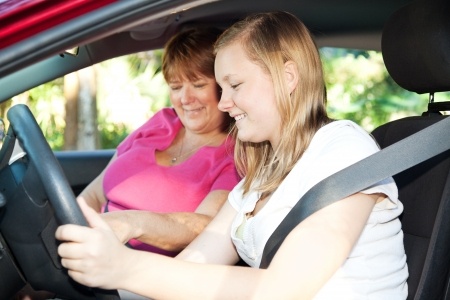 With the snowbanks nearly gone, your teen driver is likely asking for the car keys. Now is a very good time to talk to them about paying attention on the roads and following traffic laws.
With the snowbanks nearly gone, your teen driver is likely asking for the car keys. Now is a very good time to talk to them about paying attention on the roads and following traffic laws.
Young people ages 16 to 19 are nearly three times more likely to be in a fatal motor vehicle crash than other age groups. While cell phone use is a frequent cause, there is also simple inexperience. If you are a parent, you know this conversation takes a lot of work and a lot of repetition.
We offer these safety tips for teen drivers:
- Always wear your seat belt.
- Keep your hands on the wheel and your eyes on the road.
- Do not take phone calls while driving. The caller can leave a voicemail.
- Remember that under Massachusetts Junior Operator License, teen drivers are not allowed to use cell phones behind the wheel. You cannot send texts or make phone calls. If you are caught, you may be fined and your license suspended. It is important to think about these steps for the safety of others and to keep yourself out of trouble.
- If you must use your phone, pull off the road to a safe area. Put the car in park and remove the keys. Or ask a passenger to call or answer for you.
- Travel with the phone in the best place to reduce distraction. If your phone ringing or lighting up with messages distracts you, set it in a bag in the backseat.
- Remember that whatever is happening on your phone can wait, whether it is a social media post, e-mail or photo. It really can.
- Be mindful of distractions created by loud music or intense conversation. Explain to passengers you need to limit conversation while driving.
- Remember you cannot carry passengers under the age of 18 during the first six months with a Massachusetts Junior Operator License. The one exception is you can drive with siblings.
- Do not look up phone numbers or GPS directions on your phone while driving.
- Many cars have dashboard GPS systems and infotainment systems. Turn them off until you are more experienced.
Other Safe Driving Habits
- Never consume alcohol and drive. No driver should, but you are more likely than older drivers to get in car accidents because you lack driving experience.
- Before entering your vehicle, look around for other cars, trucks and hazards. Make sure you provide bicyclists and pedestrians extra time to pass.
- Shift your eyes every two seconds and check the rear-view mirror every five to eight seconds. This will help you focus on driving.
- Do not drive drowsy. If you are tired, you will be less capable of responding to potential car accidents. The Massachusetts Junior Operator License restricts young drivers from traveling between 12:30 a.m. and 5 a.m., unless accompanied by a parent. This is a good step but realize you always have to be aware of your fatigue level and make good decisions at all hours.
- Even if you have your license, keep practicing. For instance, if you are weak backing up, practice backing into a parking space in an empty parking lot with a parent. Keep practicing because you will need these skills going forward and will not always have the time to practice.
- There are construction work zones in many places. Be extra attentive, slow down and watch for workers.
- Check your speed regularly and slow down. A little extra space between you and the car in front of you can make a big difference toward preventing a car accident.
- Drive defensively. Expect the unexpected will happen and you may have to stop or change lanes.
- Signal your intentions to turn or switch lanes early enough to give others time to prepare.
- Do not drive on the highway on your own before you are ready.
- Limit the number of times you drive your friends home after sports practices, to the mail or school events. Every teenager looks forward to driving around with their friends, but teens are more likely to become distracted this way.
- Be careful in school zones and school buses. Slow down and watch out for teenagers and children walking or riding bikes. You are required to stop when school buses stop.
Drive Safely Through Road Construction
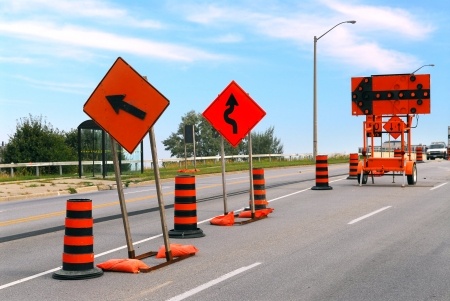 We have all looked forward to Spring this year, waiting for those snowbanks to finally melt so we can drive and walk and ride our bikes more easily. But we will face other challenges soon as construction projects return to the roads.
We have all looked forward to Spring this year, waiting for those snowbanks to finally melt so we can drive and walk and ride our bikes more easily. But we will face other challenges soon as construction projects return to the roads.
National Work Zone Awareness Week is now being observed by safety officials across the country. The annual campaign is held at the start of construction season to encourage safe driving through highway work zones and construction sites. The goal is to protect drivers, passengers, construction workers and others from injuries.
Drivers
- Drivers and passengers are at the greatest risk in a construction zone, accounting for an average of 85 percent of the deaths in highway work zone crashes, according to the Federal Highway Administration (FHA).
- In 2010, 576 people died in work zone crashes, the equivalent of one work zone fatality every 15 hours in this country, according to FHA.
Construction Workers
- Construction workers face many risks on highway work zones. In 2013, 105 construction workers died at road construction sites in this country, according to the Bureau of Labor Statistics (BLS). Other injuries are not included in this figure.
- Transportation accidents accounted for 66 percent of roadway work zone fatal occupational injuries in 2013. In 69 percent of these cases, a pedestrian worker was struck by a vehicle. Backing vehicles out accounted for 27 of the 48 pedestrian vehicular accidents.
Safety Reminders for Drivers
- Move Over. It’s the law in Massachusetts and most other states. Make sure you move over when you see construction signs and lights. And if additional room is not available, slow down.
- No Speeding. In Massachusetts, you can face double the original fine for speeding in a work zone and cause a serious car accident.
- No Distracted Driving. Pay extra attention to the roads as you travel through work zones; reduce distractions in your car from information systems and passengers.
- No Cell Phone Use. Eliminate distracted driving. Do not use your cell phone to text, check e-mail or social media. If you need to use your phone, use a hands-free system.
- Expect the Unexpected. You may not have any notice of a work zone until you are stuck in it. Be patient and be prepared to follow the signs and traffic cops and flaggers. This may mean not following the traffic signals at times.
- Pay Attention to the Signs and Look for Alternate Routes. Look for signs which direct you to detour routes and share other important information. Do not use your GPS until you are safely outside of the construction work zone.
- Mass511. The state’s traffic information system may help you avoid construction areas. Visit the webpage or call.
Safety Reminders for Pedestrians
- Use crosswalks in construction areas if it is safe to do so. If not, follow pedestrian pathways which have been marked by the construction operation.
- Watch how traffic flows before you step out into the street. You may be able to identify a safer path.
- If you know you will be walking through a work zone, consider carrying a neon glow vest and wear it as you cross a street. You want to stand out to road traffic, police officers and flaggers and the construction crew.
Safety Reminders for Cyclists
- Cyclists want to learn about roadway construction ahead of time. After all, there is nothing much worse than a mile of recently milled black top to shake your fillings loose. Call the local town or city hall or call the Mass511 service.
- Some of the cycling clubs in the Boston area also do a good job of alerting members of safety issues. One popular source of information is the Charles River Wheelmen’s safety articles. Look for cycling clubs in your area and ask if they offer a members forum or a newsletter.
Safety Reminders for Construction Workers
- Be vigilant about following OSHA and other safety procedures of your profession.
- If you are working on foot, make sure you are always aware of any vehicles around you and where there are flaggers and traffic cops.
Related links:
- National Work Zone Awareness Week.
- Highway Work Zone Accidents, by the Centers for Disease Control and Prevention.
Snow Plow Accidents Have Killed Two People in Boston Area
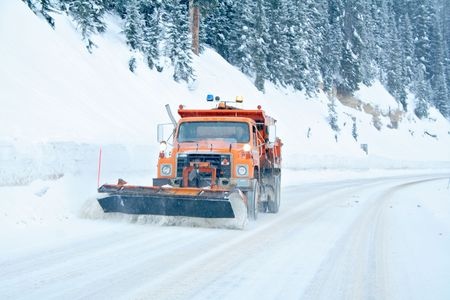 During the past few weeks, snow plows have had little rest in the Boston area and Central Massachusetts. For most of us, they have been part of the background noise of a harsh winter and we have not even noticed them. But as of this week, two pedestrians have died as a result of snow plow crashes in the Boston area. Please be aware of the risks and talk to your family members about how you can stay safe.
During the past few weeks, snow plows have had little rest in the Boston area and Central Massachusetts. For most of us, they have been part of the background noise of a harsh winter and we have not even noticed them. But as of this week, two pedestrians have died as a result of snow plow crashes in the Boston area. Please be aware of the risks and talk to your family members about how you can stay safe.
On Monday afternoon, a 60-year-old employee at a Whole Foods store in Medford was struck and killed while walking across the store’s parking lot. The employee was just leaving work. The area was not open to the public at the time. The snow plow was operated Yerardi Landscape and Design of Medfield, authorities said. The snow plow accident remains under investigation by Medford Police and the Massachusetts State Police.
A week ago, a 57-year-old Weymouth woman was struck and killed by a snow plow driver who was clearing the parking lot outside her condominium complex, Tara Gardens. The driver had just cleared the woman’s parking space for her and a friend told The Boston Globe she had gotten out of her vehicle to ask him not to block her vehicle in as he left. Weymouth Police and the Norfolk County District Attorney’s office are investigating the snow plow death.
We share a few safety tips:
1) Listen to Advisories. Follow the recommendations of state and local officials about when it is best to avoid walking or driving outside.
2) Wear Neon-Colored Vests and Bright Clothing. If you are walking in the street, a neon vest or bright clothing should be a requirement, even during the day. You want snow plow drivers, as well as other drivers, to see you.
Keep a vest in your car. You can use your vest when walking from your car to your destination. It may also come in handy someday if you break down.
3) Do Not Approach Plow Trucks. Pedestrians should never approach plow trucks. Let them stay focused on removing snow.
4) Contact the Property Owner Instead. If you live in an apartment or condo complex, keep the phone number of your building management company handy on your cell phone. If you have a complaint, take a photo to send to the building owner, who can share it with their plow company.
Do the same if you work at a business office, unless you are the owner; then safe snow removal is your responsibility.
5) Expect Plows Everywhere, Even After the Snow Ends. Expect plows everywhere for a while. Even when it is not snowing, expect plows will be out trimming down high snow banks and opening up narrow roads.
6) Do Not Follow Plow Trucks Too Closely. When driving, stay a few car lengths behind plow trucks. The snow plow could hit something hard unexpectedly and not be able to stop. Avoid passing snow plows.
7) If You Have An Accident with a Snow Plow Truck. If you are driving, make sure you stop in a safe place. As you do, take note of what the plow truck looks like and the license plate if you can do so safely. If the plow driver does not stop, immediately notify the local police department to file a car accident report.


